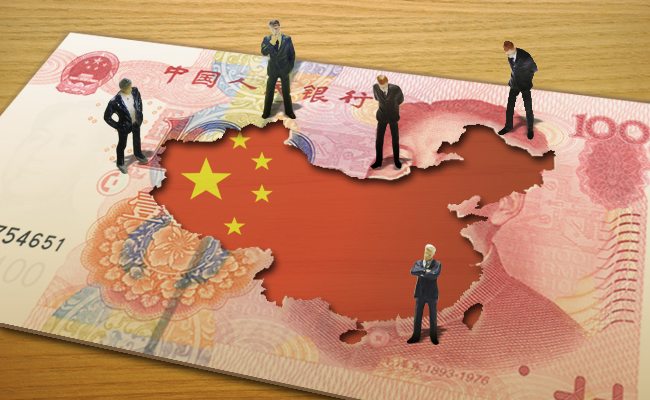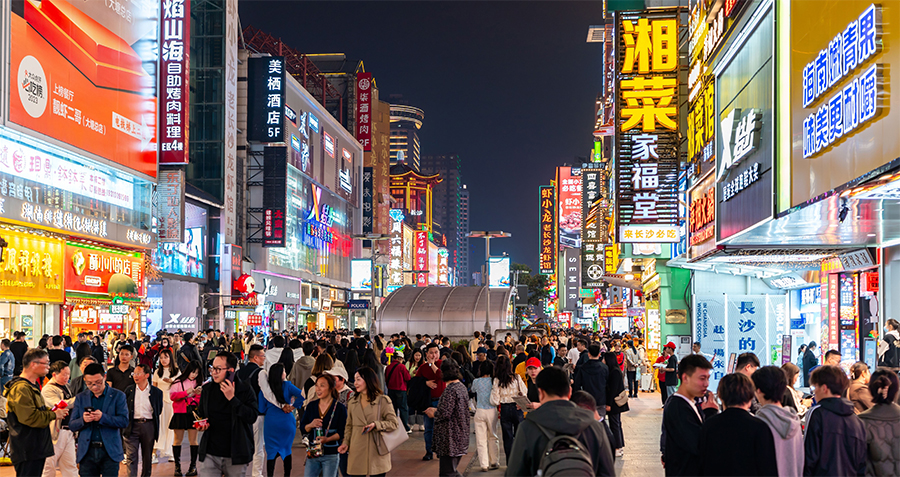
Arthur Kroeber, author of China’s Economy: What Everyone Needs to Know, talks about how China got here and where it might be headed
Arthur Kroeber is managing director of the Beijing-based economic research firm Gavekal Dragonomics—formed in 2011 via merger with Dragonomics, which he co-founded in 2002—and editor of its journal, China Economic Quarterly. He is also a senior fellow of foreign policy at the Brookings-Tsinghua Center in Beijing. He worked as a financial reporter in Asia from 1987-2002.

Kroeber is the author of China’s Economy: What Everyone Needs to Know, a comprehensive introduction to China’s rise from an economic backwater in the early 1980s to the world’s second-largest economy. As he describes, the country has achieved almost miraculous advancement in a mere 30 years, but at the same time is beset with a host of structural problems and contradictions that it must grapple with, especially as economic growth begins to slow. In this interview, Kroeber offers his analysis on how China got here, where it might be headed, and how to understand the changes and implications.
Q. You come from a background studying history, rather than economics, and that informed your book, China’s Economy: What Everyone Needs to Know, a great deal. Why is the historical perspective necessary in talking about the Chinese economy?
A. It’s true in talking about any economy, because an economy is not a bunch of math equations, it’s a bunch of arrangements between people and the institutions they create and evolve over time. I have a pretty strong view that in any economy you have to look first at the underlying political arrangements and understand how they create certain kinds of conditions and constrain economic policymaking… I think it is particularly important in a place like China that is not a mature, relatively slow-growing developed economy, where there is greater space for just looking at economics from a technical perspective. China has a fast-growing economy where the structures are changing very quickly, and that increases the importance of understanding the historical and the political context.
Q. Maybe also, and this is my guess, if you were in the United States and you were talking about a European economy, there is a certain level of commonality there, whereas China is very different from what you already know.
A. Yes. The other thing is that a lot of economic analysis was developed in the United Kingdom initially, and then taken over by the United States, and a lot of modern economic analysis really takes its starting point assumption as the US is kind of the normal situation for all economies. But development economists have understood for many, many years that the rules that apply to a developed economy, and specifically the US, often to do not apply to a developing economy.
Q. Are there any limits or pitfalls in tackling economic understanding from the historical perspective?
A. There’s certainly a lot less limits and pitfalls that arise as a result of taking into account political and historical factors than arise from ignoring them. Any perspective obviously has some bias and I think the biggest bias is not so much from the historical perspective, but it’s from the outsider’s perspective, right? I’m a foreigner, I’m not Chinese, I haven’t grown up in this society and that imposes certain limitations on my scope of vision, and the book I wrote is essentially for a foreign audience. I hope it can be useful to Chinese readers as well, but there is a very different perspective that people inside a country have on their own development, as opposed to people from outside a country.
Q. Why do you think people tend to get hung up on drawing conclusions from certain headline numbers, like GDP, and how can one guard against that habit?
A. I think it’s the natural tendency if you are looking at a large and complex thing that’s very difficult to understand, to try and boil that down to a certain small number of variables or factors that we can easily analyze, and we all do that to varying degrees. You just have to understand that every time you make a simplification there’s a cost to that, and you should, as a matter of intellectual honesty, go back and reexamine your assumptions from time to time.
On that specific thing, there are a couple of factors. First of all, there is a degree of historical amnesia, that countries that are already rich very quickly forget how they got rich. They assume that the way they are now is the way that they’ve always been, and so a simple example would be that the US is a highly market-driven consumer economy, and many elements of that are not the reasons we got rich, but the consequences of getting rich. So losing sight of what the causes and consequences are is something that’s very easy to do.
The second thing more has to do with international geopolitics and geo-economics, that when China hit its most intensive investment stage in 2005, 2006, 2007, this had some pretty substantial impacts globally, in terms of interest rates, wages and so forth elsewhere in the world. China had a huge current accounts surplus for example, and this was very difficult for the rest of the world to absorb. A lot of other countries took the view that the way that [China was] growing was causing problems, therefore [China] should stop growing that way, and that is a legitimate conversation to have.
Q. My general sense right now is the popular view on China and its economy is one of pessimism, but is that attitude a grounded one?
A. “Popular” in my view would be what most people think. If you look at the latest Pew Global Attitudes survey, one notable fact in there is that a number of people in the United States considered China to be the world’s leading economic power and the US number two from about 2010 to about 2012, or 2013. In the last couple of years that’s started to shift and now a clear majority of Americans are back to thinking the US is the number one power economically and China is number two. To me that’s not pessimism, that’s just a kind of return to reality, because if you look at any metric, absolute size of GDP, level of technological development, influence over global trading and investment institutions, the US is far more important and influential than China. So the aberration was this period where people thought that China was taking over the world because of its high growth rate. What we now have is a more realistic assessment, [which is that] it’s a very large economy, it continues to grow very fast, but it has a lot of problems. And just because you are growing fast doesn’t mean that your absolute position in the world has changed all that much. So think at the popular level there is a pretty clear-sighted understanding now of where China stacks up globally. [But] when you talk about representations in the media and in the financial world, I think you get some very clear biases. [In] the media… there is a tendency to look for hot stories, and often exaggerate trends of the moment. So when China is growing fast the tendency is to say they are taking over the world, and when it slows down there is a tendency to exaggerate that and say everything is terrible. That’s just a natural feature of the news cycle… There are parts of the financial sector that look particularly at the financial risks in China and say [that] these look very high and therefore the financial system is going to blow up and it’s all going to be a disaster. And that I think is an exaggerated view that stems from a very narrow perspective.
Q. In the book you made a point about switching away from investment-led growth to increasing efficiency. What does that mean?
A. When an economy starts out very poor, as China was 35 years ago, and moves toward becoming rich, it basically has to go through two phases. The first phase is just simply accumulating a lot of capital, because the way that you get rich is that you have a lot of capital to play with. Poor countries are poor because they don’t have a lot of capital, they don’t have factories, they don’t have infrastructure. So if you are a worker and you have nothing to work with except your bare hands, metaphorically speaking, it’s hard for you to be productive. But if you have access to modern machinery, modern technology, modern transportation networks and so forth, you have a lot more than your hands to work with. You can multiply the value of your labor many times. The difference between a rich country and a poor country is that a rich country has a lot of capital endowments. So stage one is to just accumulate as much capital, as much technology, as much infrastructure, as much industrial capacity as you can…
But then what happens is that you get, basically, to a point where your capital endowment is roughly where it needs to be for a modern economy, and then you don’t have to throw that much more capital into the system. And the way you understand this is happening is that when you don’t have that much capital you can almost randomly build new infrastructure, and it will generate a very high return… But then as you get closer to that frontier, what happens is that the return on those capital investments starts to go down, and you start to observe that if you put in another mile of road, or another power plant, or a steel factory, the return on this investment is way lower than it used to be… Then what you are left with is that the only source of economic growth is greater productivity, which means getting a higher return out of the capital that you have already installed.
My argument is that China clearly is several years into this transition where returns on capital have been declining, basically since 2008, and very steeply in some [sectors]. And in the future, if you look at the next 10 or 20 years of Chinese growth, they are going to have to keep building more capital resources, but at a much slower rate than in the past. Most of your economic growth is going to come not from throwing new capital into the system, but by becoming more efficient and more productive in using the capital that you already have.
Q. But how do you go about making those efficiency gains?
A. This is the big question, and economists will give you, with great authoritative voices, very clear answers to this. But in my view it’s harder to say. I think every country has to feel its way toward that, and it is not easy. But the simplest way of thinking about this is that an awful lot of energy has been devoted to channeling investment into basic infrastructure, basic industries, [which are] capital intensive projects. And you now need to channel investment more towards service sector activity, consumer-facing activity, because that’s where the returns are.
I think the second dimension of this is that, fundamentally, when you are in this capital accumulation phase of growth, a strong state and state-owned enterprises can be very useful agents, because it is fairly obvious what you need to do, and it does not require a high degree of complex thinking. And you also need to tolerate a situation where you might build some infrastructure that you don’t get much of a financial return on immediately. So state companies that are not focused on quarterly returns, but just getting stuff done, can be very useful. When you are just building stuff it is fine to have a big state and a lot of state-owned enterprises.
But when efficiency is the main thing, we know from a wealth of data that state-owned firms are much less efficient at using capital than private firms. And much less nimble at catering to consumer demand. So it seems pretty clear that one of the ways that you make this transition is that you streamline your state-owned enterprise sector, you reduce your reliance on the command economy, and on state-driven growth mechanisms, and you allow a bigger role for the market and for the private sector. There are a lot of ways that you can do this, a lot of places that you can draw this line in terms of how much state and how much market that you want, but the direction, I believe, very clearly has to be towards less state and more market.
Q. Do you think China is moving in the right direction with those adjustments?
A. It’s unclear. You look at certain metrics and you can see that the private sector share of almost every economic indicator continues to grow, but it is growing at a much slower rate than it was five or six years ago. So the impetus toward a more market-driven, more private sector economy seems to have weakened. And at the top level of policy you see President Xi Jinping has basically outlined a vision of economic growth that is very heavily reliant on a big role for the state-owned enterprises. There is an emphasis on consolidating SOEs so that they are even bigger. There doesn’t seem to be a lot of appetite in the government at the moment for large-scale deregulation to reduce the state role in any given sector. So we are getting mixed signals, but I think one of the signals we are getting is that there is a very strong desire to keep a very large state role in the economy, and in my opinion that does create a real problem. That’s a real obstacle to China making the move to a more efficiency-driven economy.
Q. How would you place your bets on the future?
A. [After a few years] the problem [will be] you are left with an economy that is still highly reliant on credit, where the quality of that credit has deteriorated and lead to a lot more bad loans in the banks, and you have a need to have a significant correction to the property market because it has just been allowed to go too fast for too long. And I think at that point, you really get down to the question of, is the government really going to make the structural changes in the economy necessary to reduce reliance on investment, focus more on consumption, get more market forces to reduce the role of the state, to have a more private-oriented economy? If the answer to that question is yes, then I think that what you likely have is a much more volatile and complicated period from 2018-2020. If they try to execute some of these reforms you may have some real hits to growth, because a lot of these reforms will, in the short run, reduce economic activity.
But at the end of the day, if all of that is done successfully, you could wake up in the early 2020s and the economy could be growing in a healthy way, without a huge increase in credit, at maybe 5% a year. That’s the good scenario, and I think that is about the best we can anticipate.
So then let’s assume that they don’t do those reforms because they are too difficult or too complicated or they don’t really want to do them—what happens then? I think there are two possible outcomes. One is that you have a buildup of pressures in the financial system and it just blows up in some kind of crisis. That’s what a lot people in the hedgefund community and the financial industry in general tend to worry about—that this steady increase in the debt level in the economy ultimately will lead to some kind of crisis moment. And I think that’s possible, we can’t discount it. But I actually think that’s less likely than another bad scenario.
That scenario is that the government has enough resources to anticipate a financial crisis and stop it from happening, but the way they do that is essentially the way that Japan did it in the 1990s, which is that they throw more and more money into more and more infrastructure projects, which keeps the economy ticking over, and prevents the necessity for people to recognize bad loans and restructure.
But because the productivity of this capital is falling you just get into slower and slower growth all the time, and where you wind up at the end of the day is that the economy is barely growing at all, and is piling up higher and higher levels of debt. And you get there without an obvious crisis, but you end up with a high-debt, low-growth stagnation scenario.
It may seem weird to talk about that in China today because it’s a pretty vibrant economy still, and growing pretty fast. But you know, if we don’t see a major change in the economic policy direction, I think that’s basically where we wind up seven or eight years from now. And as Japan’s experience has shown, once you get into that trap, it is very difficult to get out of it. And it is particularly difficult to get out of it if you have a rapidly aging population, which China will have worse than Japan.
Right now, China looks like Japan in 1980—a lot of workers, not that many retirees, but 20 years from now China will basically look like Japan today. Very few workers, and a lot of retirees. It’s hard to get growth from that dynamic. So I tend to think that if you have a bad outcome in China, it will be expressed not through a blowup or crisis or something exciting happening, but a long, slow slide into stagnation.



















